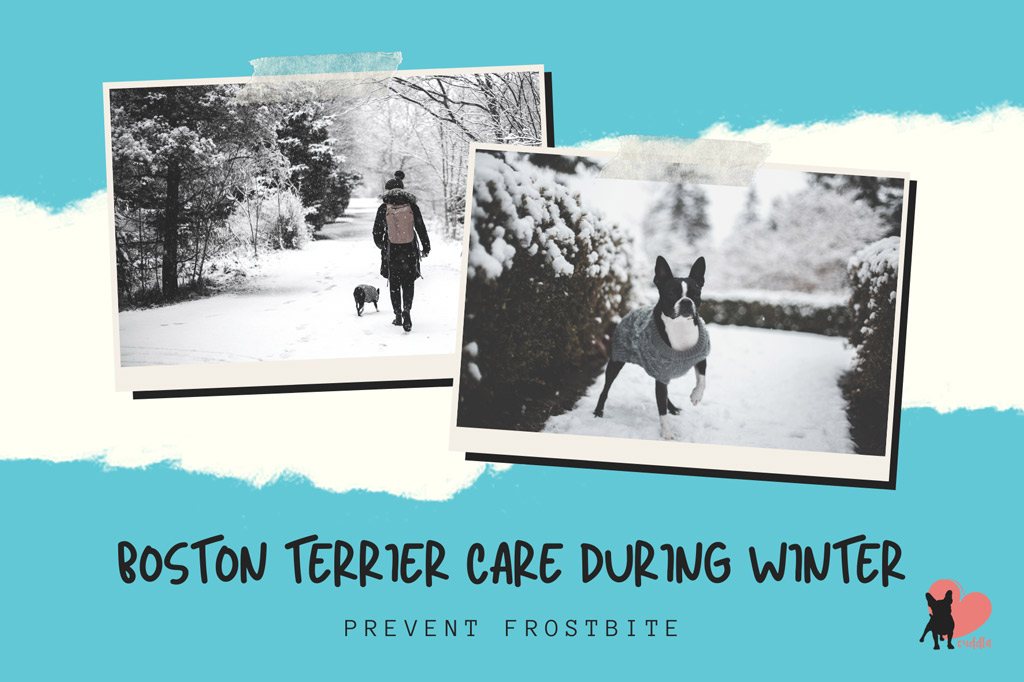
Ever felt unsure about how your Boston fares during the winter, cold weather…
Can Boston Terriers handle cold weather? Not really, so you need to take extra care when it gets cold!
Boston Terriers are short-nosed / flat-faced (a brachycephalic breed trait), which means they don’t regulate body temperature as efficiently as other dogs do (especially compared to longer-nosed breeds).
On top of that, they have a short, single coat that doesn’t provide much insulation against extremely cold weather.
Continue reading for Boston Terrier care in winter and also how to prevent frostbite and hypothermia!
Boston Terrier Care in Winter
During cold weather, most dogs will experience the drop in temperature, and in Boston Terrier’s case, their coat won’t be enough to keep them warm.
You will probably want to make sure that your furry friend stays safe, warm, and comfy all winter long.
Before jumping into the tips for winter… let’s define what “cold” is for a Boston Terrier.
What is a safe temperature for a dog to be outside in winter?
Temperatures lower than 32 degrees Fahrenheit (0 degrees Celcius) can cause hypothermia or frostbite.
Here’s a chart illustrating the risks of low temperatures for dogs:
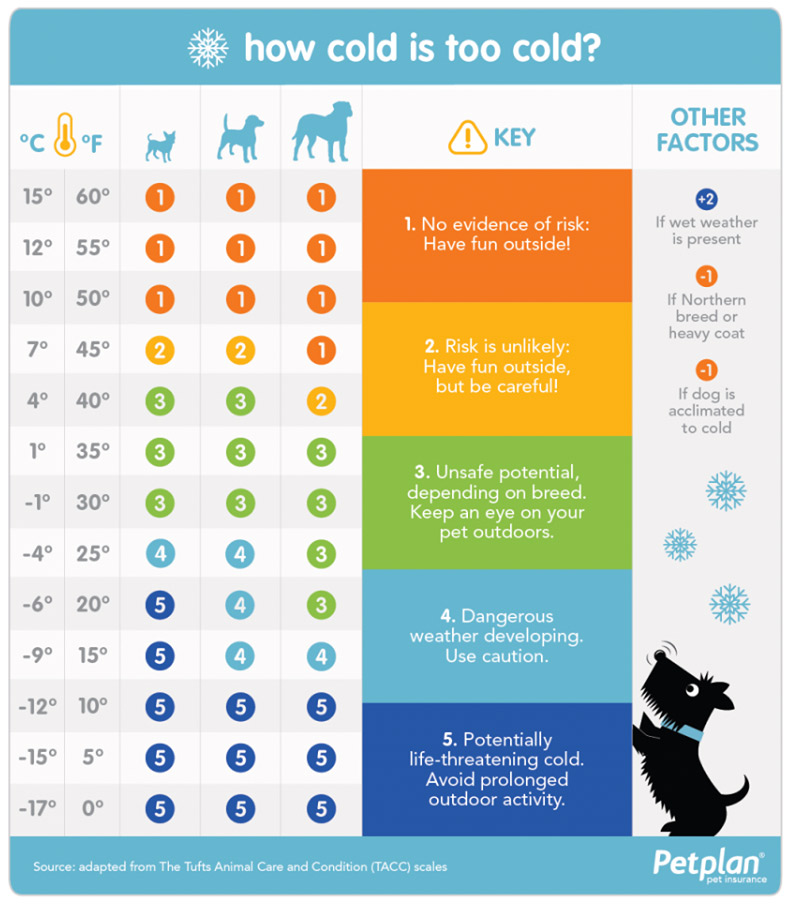
#1 – Start by Taking Your Boston Terrier for a Check-Up
Visiting your vet in the fall, early winter, and before summer starts is a good way to ensure that your Boston Terrier is healthy before the weather changes.
Also, annual check-ups are a great way to prevent any health issues, especially for seniors, and to monitor breed-related problems.
You’ll also want good insurance cover that will help with any unexpected expenses…
This is where Petplan Pet Insurance shines, as they give you the right cover you need without the worry of say settling a claim quickly or paying your vet directly. They try to make insuring your pet as easy as possible.
#2 – Know When Your Boston Terrier Is Cold
If possible, avoid exercising your Boston outdoors early in the morning or late in the evenings. The warmest time will be lunchtime or early afternoon when the sun and the temperature are at their highest.
Protecting your Boston Terrier from frostbite and hypothermia is key, so it’s important to recognize the signs that your dog is uncomfortably cold, which include:
- Whining.
- Shivering.
- Appearing anxious.
- Slowing down or stopping.
- Looking for a warm place to burrow.
If you notice any of these signs, you should:
- Bring your pooch indoors immediately.
- Dry your Boston if necessary and offer him warm water.
- To be safe, call your vet to make sure your dog is safe from hypothermia or frostbite.
Insider Tip: Boston Terriers with chronic disease, puppies and older animals are more vulnerable to the cold than healthy youngsters and adults.

#3 – Get Your Boston Terrier to Wear a Sweater
As you now know, Boston Terriers are not naturally able to keep themselves warm.
When stepping outside, a sweater is a great way to keep your Boston warm! Not all dogs tolerate them, but many get used to them after a few tries.
For facing those cold winter months, you might want to consider:
- Keeping your dog warm on a sunny day: with a knit sweater, a hoodie or a fleece.
- Proofing your pooch against the wind and rain: with a classic poncho, a print raincoat or a waterproof coat.
Insider Tip: Keep in mind that all dogs, including Bostons, lose most of their body heat through the pads of their feet, their ears, and their respiratory tract. So there’s a limit to how much warmth a sweater or jacket will provide.
Read also: Do Boston Terriers Need Sweaters in Winter? – Includes a guide on How to Measure Your Boston Terrier and How to Choose a Sweater!
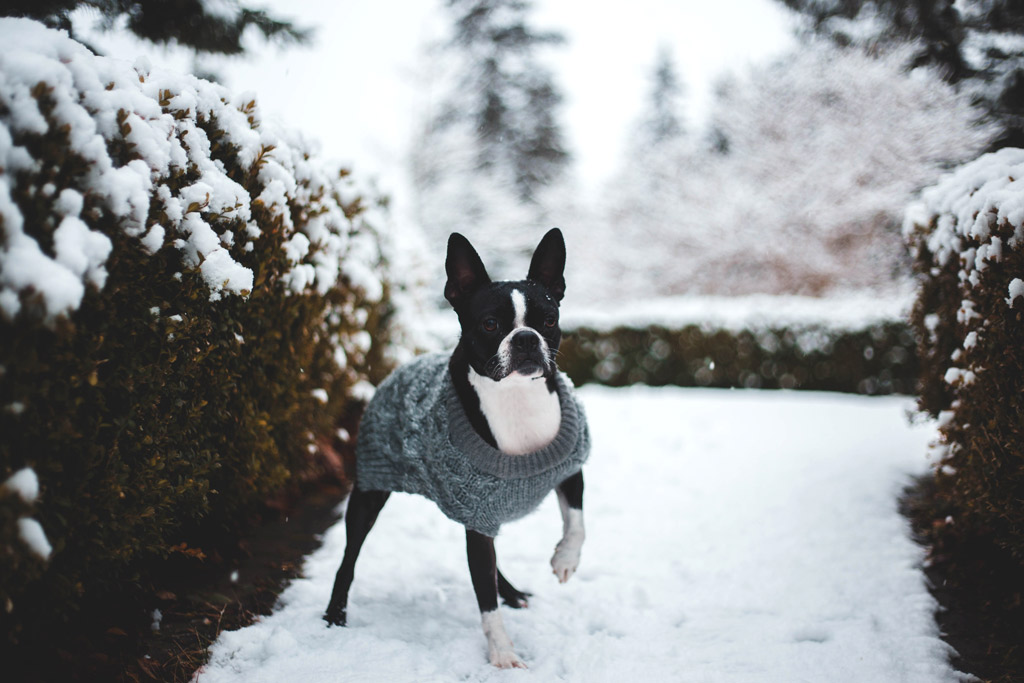
#4 – Keep Your Dog Well-Exercised
It’s really important to maintain your Boston Terrier’s physical condition all year-round.
If you allow your dog to become a couch potato all winter, you increase his risk of injury when he starts exercising again in the spring. Plus, you are also increasing his chances of weight gain due to lack of exercise!
So, continue with the daily walks. Just make sure to keep your pooch on the lead at all times to avoid:
- Your Boston getting lost.
- Getting in contact with antifreeze liquid – just a single teaspoon of this can cause kidney failure.
- Or getting in a dangerous situation like a frozen pond or lake. Dogs can easily fall through the ice, and it’s very difficult for them to escape on their own, or for humans to rescue them.
Don’t forget about mental stimulation!
There are many great ways to keep your Boston engaged at home too. Check my favourite toys for some practical solutions!
Read also: Do Boston Terriers Like Snow? – Tips for Winter Walks.

#5 – Protect Your Boston Terrier’s Paws
There are a surprising amount of harmful things that a dog’s paws can pick up during winter:
- Rock salt.
- Ice.
- Antifreeze.
- And other toxic chemicals during winter.
So to prevent ingestion of toxins, thoroughly wipe off your Boston’s feet, legs and underside after he’s been outside. Personally, I use these dog wipes to do it.
Also, as Boston’s paws can become chapped and raw because of the snow, you should regularly check your dog’s paws for any signs of injury or bleeding from walking on frozen or snow-packed surfaces.
Dog booties can provide coverage and also prevent salt from getting lodged between bare pads, which causes irritation. Let your furry friend get used to booties gradually.
Although boots can be a great solution to protect your Boston Terrier’s paws, you might find out that your pooch won’t want to wear them!
That’s ok, you could use natural wax instead, like Musher’s, which I find more practical.
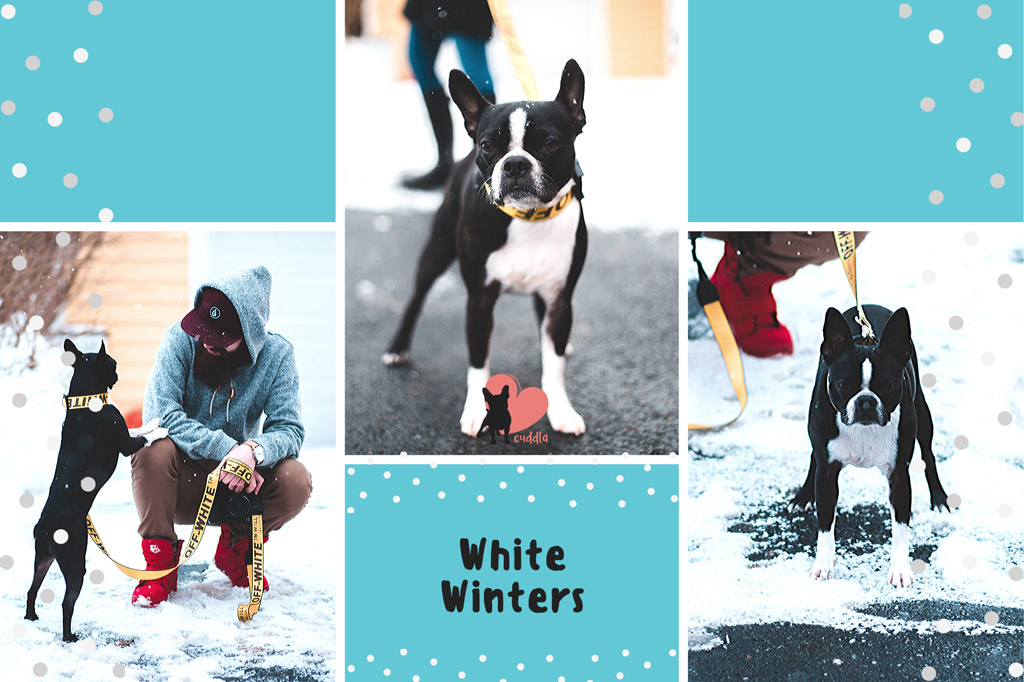
#6 – Keep Your Boston Terrier Mostly Indoors
Since Bostons don’t do well with extreme temperatures, you should keep your pooch mostly indoors.
When at home, here are two safety measures to beware of:
- Have your home heating system inspected: It’s a good idea to have your heating unit checked for carbon monoxide leaks before winter sets in. Carbon monoxide is odourless and invisible, but it can cause serious health problems in both people and pets.
- Keep your pooch safe from heat sources: If you have a fireplace or heater, expect your Boston to lie near it for warmth. That’s okay if you ensure that no part of your dog’s body comes in contact with flames, heating coils or other hot surfaces. Your Boston can easily get burned or get the household in danger.
Also, be extra careful if your Boston is a senior.
Cold weather can be especially difficult for those with degenerative joint disease or other chronic, debilitating condition.
Talk with your veterinarian about physical therapy and other safe, natural methods for improving your Boston’s comfort and mobility during cold weather.
At home, have a thick, soft, non-toxic bed for your Boston Terrier in a warm room for naps and for bedtime. Check my best dog beds guide to choose the right one according to your dog’s needs. Don’t forget about a warm blanket like this one!

#7 – Prevent Your Boston Terrier’s Scaping Chances
Keeping your Boston on a leash is a great safety measure (like I mentioned in #4 – Keep Your Dog Well-Exercised section above).
Sadly, more dogs go missing in the winter months than at any other time of year. It’s very easy for your Boston to lose his scent and get lost when there’s snow or ice is on the ground.
That’s why it’s good to make sure your dog’s ID tag is current and keep him on a lead outdoors.
Also, you can protect your dog from going missing with Tractive, a GPS tracking device attached to your dog’s collar! This will allow you to locate your dog every time. 🙂
P.S. Remember that Boston’s walk better on a harness because it doesn’t interfere with their breathing.
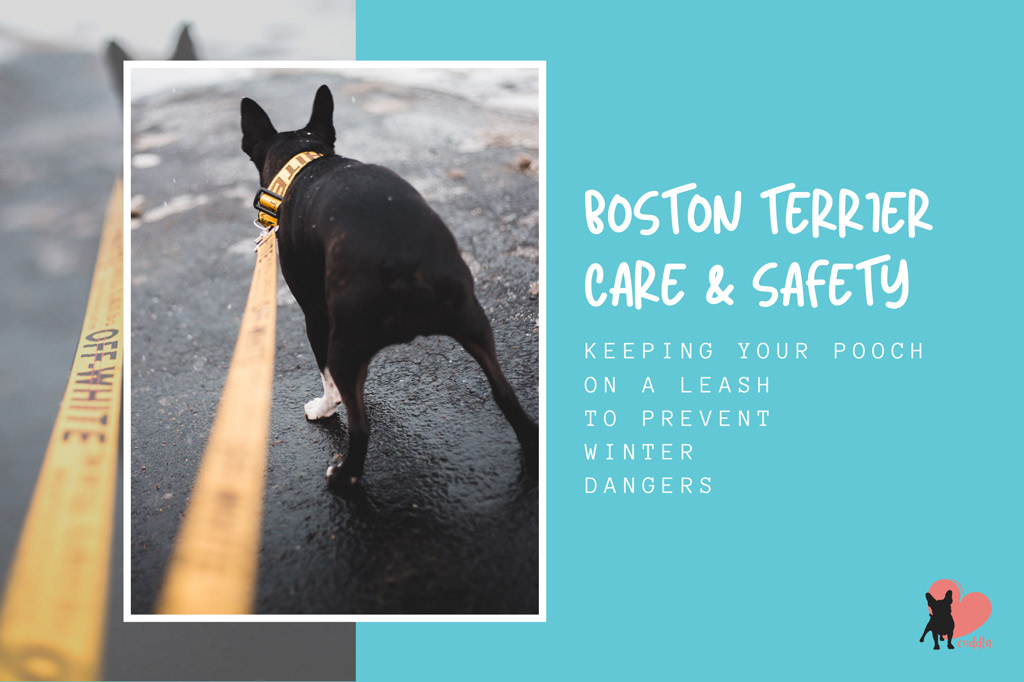
#8 – Never Leave Your Boston Terrier Alone in the Car
Finally, don’t leave your pooch in the car alone. No matter if you leave the car heating on, it’s just not safe.
Better be safe than sorry! So, plan ahead to avoid having to leave your pooch unattended. 😉

P.S. For hot weather, check Boston Terrier Care in Summer – 8 Tips to Prevent Overheating blog post.
Finally, the key to a happy and healthy Boston Terrier has much to do with a dog’s welfare needs. Boston Terrier Care is a great next step to take. 😉
